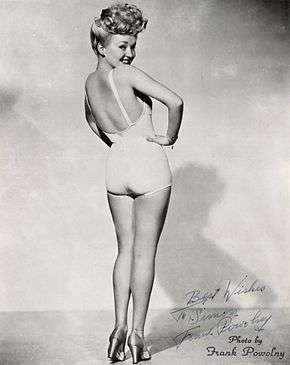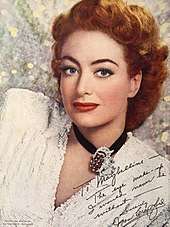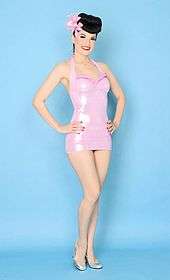Pin-up model
A pin-up model (known as a pin-up girl for a female and less commonly male pin-up for a male) is a model whose mass-produced pictures see widespread appeal as part of popular culture. Pin-up models were variously glamour models, fashion models, or actresses. Pin-ups are intended for informal display, i.e. meant to be "pinned-up" on a wall, which is the basis for the etymology of the phrase. These pictures are also sometimes known as cheesecake photos.[lower-alpha 1] Cheesecake was an American slang word that became a publicly acceptable term for scantily clad, semi-nude, or nude photos of women because pin-up was considered taboo in the early 20th century.[1]

The term pin-up may refer to drawings, paintings, and other illustrations as well as photographs (see the list of pin-up artists). The term was first attested to in English in 1941[2] even though the practice is documented at least back to the 1890s. Pin-up images could be cut out of magazines or newspapers, or they could be on a postcard or lithograph. Such pictures often appear on walls, desks, or calendars. Posters of these types of images were mass-produced and became popular starting from the mid-20th century.
Male pin-ups (known as beefcake) were less common than their female counterparts throughout the 20th century, but they have always been around. In particular, pictures of popular male celebrities were targeted at women or girls; examples include James Dean and Jim Morrison.
History
Beginning in the early 19th century, pin-up modeling had "theatrical origins"; burlesque performers and actresses sometimes used photographic advertisement as business cards to advertise shows. These promotion and business cards could often be found backstage in almost every theater's green room, pinned-up or stuck into "frames of the looking-glasses, in the joints of the gas-burners, and sometimes lying on-top of the sacred cast-case itself."[3] "To understand both the complicated identity and the subversive nature of the 19th-century actress, one must also understand that the era's views on women's potential were inextricably tied to their sexuality, which in turn was tied to their level of visibility in the public sphere: regardless of race, class or background, it was generally assumed that the more public the woman, the more 'public,' or available, her sexuality”, according to historian Maria Elena Buszek. Being sexually fantasized, famous actresses in early-20th-century film were both drawn and photographed and put on posters to be sold for personal entertainment.[4] Among the celebrities who were considered sex symbols, one of the most popular early pin-up girls was Betty Grable, whose poster was ubiquitous in the lockers of G.I.s during World War II.
In Europe, prior to the First World War, the likes of "Miss Fernande" (who some identify as Fernande Barrey[5][6]), were arguably the world's first pin-ups in the modern sense. Miss Fernande displayed ample cleavage and full frontal nudity, and her pictures were cherished by soldiers on both sides of the First World War conflict.
Other pin-ups were artwork depicting idealized versions of what some thought a particularly beautiful or attractive woman should look like. An early example of the latter type was the Gibson Girl, a representation of the New Woman drawn by Charles Dana Gibson. "Because the New Woman was symbolic of her new ideas about her sex, it was inevitable that she would also come to symbolize new ideas about sexuality."[7] Unlike the photographed actresses and dancers generations earlier, fantasy gave artists the freedom to draw women in many different ways.[8] The 1932 Esquire "men's" magazine featured many drawings and "girlie" cartoons but was most famous for its Vargas girls. Prior to World War II they were praised for their beauty and less focus was on their sexuality. However, during the war, the drawings transformed into women playing dress-up in military drag and drawn in seductive manners, like that of a child playing with a doll.[9] The Vargas girls became so popular that from 1942–46, owing to a high volume of military demand, "9 million copies of the magazine-without adverts and free of charge was sent to American troops stationed overseas and in domestic bases."[10] The Vargas Girls were adapted as nose art on many World War II bomber and fighter aircraft; Generally, they were considered inspiring, and not seen negatively, or as prostitutes, but mostly as inspiring female patriots that were helpful for good luck.[11]
Among the other well-known artists specializing in the field were Earle K. Bergey, Enoch Bolles, Gil Elvgren, George Petty, Rolf Armstrong, Zoë Mozert, Duane Bryers[12] and Art Frahm. Notable contemporary pin-up artists include Olivia De Berardinis, known for her pin-up art of Bettie Page and her pieces in Playboy.
Feminism and the pin-up
Buszek said that the pin-up girl "has presented women with models for expressing and finding pleasure in their sexual subjectivity".[13]
According to Joanne Meyerowitz in "Women, Cheesecake, and Borderline Material" an article in Journal of Women's History, "As sexual images of women multiplied in the popular culture, women participated actively in constructing arguments to endorse as well as protest them."[14]
As early as 1869, women have been supporters and protesters of the pin-up. Female supporters of early pin-up content considered these to be a "positive post-Victorian rejection of bodily shame and a healthy respect for female beauty."[15]
Additionally, pin-up allows for women to change the everyday culture. The models "...succeed in the feminist aim of changing the rigid, patriarchal terms".[13]
It has further been argued by some critics that in the early 20th century, these drawings of women helped define certain body images—such as being clean, being healthy, and being wholesome—and were enjoyed by both men and women; as time progressed these images changed from respectable to illicit.[16]
Conversely, female protesters argued that these images were corrupting societal morality and saw these public sexual displays of women as lowering the standards of womanhood, destroying their dignity, reducing them to mere objects to pleasure men and therefore harmful to both women and young adolescents.[15]
Pin-up modeling is a subculture that is invested in promoting positive body images and a love for one's sexuality, "...pin-up would also find ways to… encourage the erotic self-awareness and self expression of real women".[13]
Hair and makeup style

The classic style of the pin-up originates back from the 1940s. Due to the shortages of materials during WWII, this period of makeup is considered the "natural beauty" look.[17] The US was immersed in war-time economy, which put distribution restrictions on consumer goods.[18] General rationing was supported; women applied mild amounts of products. Despite the rations, "Women were encouraged to keep buying lipstick and to send letters to the front covered in 'lipstick kisses' to boost the morale of the soldiers."
The products consisted of:
- "Foundation – A cream base, liquid foundation that matched their natural skin tone,
"having a sun-kissed glow was popular among white women.[19]
- Compact Powders – used to set the foundation and even the overall complexion.
- Eyes and brows – neutral contour on brow bone and lid. Eyebrows were shaped but kept full.
- Eyeliner – the wing effect became popular by the1950s.
- Blush – pastel and rose colors applied to the apple of the cheek.
- Lips – vibrant red and matte color, applied to look plumper.[20]
Lipstick "turned into a symbol of resilient femininity in the face of danger"[22] and was seen as a way to boost morale during the war. The shape of the lip was also iconic of the 1940s. The lips were painted on to look plumper, a broad outline of the lip was added for roundness. This fuller look is known as the "Hunter's Bow", invented by Max Factor.[23]
The pin curl is a staple of the pin-up style, "women utilized pin curls for their main hair curling technique".[24] Originating in the 1920s from the "water-waving technique", the hair style of the 1940s consisted of a fuller, gentle curl. The drying technique consists of curling a damp piece of hair, from the end to the root and pin in place. Once the curl is dry, it is brushed through to create the desired soft curl, with a voluminous silhouette.[24]
Victory rolls are also a distinctive hairstyle of the pin-up. The Victory roll is curled inward and swept off the face and pinned into place on the top of the head. Soft curls, achieved through the pin curl technique, finish off the look of pin-up.[25]
As a makeup style, the classic pin-up underwent a revival in modern fashion. The red lip and winged eyeliner made a re-emergence in 2010, with singer, Katy Perry being the most accessible example of modern pin-up makeup.
Some people believe there is a lack of representation in the media of black women as pin-up models, even though they were influential to the construction of the style and were just as glamorous.[26]
As a makeup style, it is simple and sleek makeup, that is noticeable and glamorous.
Pin-up in the contemporary age

Although pin-up modeling is associated with World War II and the 1950s, it developed into a subculture which can be seen represented in the styles of some celebrities and public figures. Pamela Anderson was considered the "perennial pin-up" due to decades' worth of modeling for Hugh Hefner's Playboy magazine.[27] The American singer Lana Del Rey, whose style is comparable to that of the classic pin-up model, has performed a song called "Pin Up Galore".[28] Beyoncé has recorded a song titled "Why Don't You Love Me"[29] which pays tribute to the American pin-up queen of the 1950s, Bettie Page. The burlesque performer Dita Von Teese is often referred to as a modern pin-up. She has appeared in a biographical film about Bettie Page, Bettie Page Reveals All,[30] in which Von Teese helps to define pin-up. Katy Perry makes use of the ideas associated with pin-up modeling, and has included these in music videos and costumes. The Victoria's Secret Fashion Show can be comparable to burlesque show, whereas their yearly advent calendar can compare to pin-up in general.[31]
The pin-up modeling subculture has produced magazines and forums dedicated to its community. Delicious Dolls,[32] a magazine that began in 2011 and has both a print and digital version, was described in 2015 as "the most-liked" pin-up magazine in the world. One of the magazine's mission statements is "to promote and showcase retro and modern pin-up girls". The magazine supports pin-up-related events throughout the United States and allows anyone to be featured in the magazine as long as they have worked with an approved photographer. Within this subculture there are opportunities to perform in pin-up contests, including one which takes place during the Viva Las Vegas rockabilly festival.[33]
African-American pin-up

Though Marilyn Monroe and Bettie Page are often cited as the classic pin-up, there were many black women who were also considered to be impactful. In the 1920s two of the most notable Black burlesque dancers were Josephine Baker and Lottie Graves. Despite the little history on Black burlesque dancers, Baker and Graves are a good starting point for evaluating black women in pin-up. Dorothy Dandridge and Eartha Kitt also added to the pin-up style of their time, using their looks, fame, and personal success. African-American pin-up finally had a platform when the magazine, Jet, was created in 1951. Jet supported pin-up as they had a full page feature called, "Beauty of the Week", where African-American women posed in a swimsuits and such. This was intended to showcase the beauty these women possessed as they lived in a world where their skin color was under constant scrutiny. It was not until 1965 that Jennifer Jackson became the first African American to be published in Playboy as Playmate of the Month. And it was not until 1990 that Playboy's Playmate of the Year was an African-American woman, Renee Tenison. Historically, black women in pin-up are still not as common as their white counterparts. However, the recent revival of pin-up style has propelled many black women today to create and dabble with the classic pin-up look to create their own standards of beauty. In Jim Linderman's self-published book, Secret History of the Black Pin Up,[34] he describes the lives and experiences of African-American pin-up models.
See also
References
Notes
- Merriam-Webster Online defines a "cheesecake" as "a photographic display of shapely and scantily clothed female figure".
Citations
- Meyerowitz, Joanne (1996). "Women, Cheesecake, and Borderline Material: Responses to Girlie Pictures in the Mid-Twentieth-Century U.S." Journal of Women's History. 8 (3): 9–35. doi:10.1353/jowh.2010.0424. ISSN 1527-2036.
- Ayto (2006), p. 126.
- Buszek, Maria Elena (2006). Pin-Up Grrrls: Feminism, Sexuality, Popular Culture. Duke University Press. pp. 42–44. ISBN 9780822337461.
- Carole S. Vance, ed. "Seeking Ectasy on the Battlefield: Danger and Pleasure in Nineteenth-Century Feminist Sexual Thought," in Pleasure and Danger: Exploring Female Sexuality (Boston: Routledge and K. Paul, 1984)
- "Dazzledent: Fernande Barrey". Tumblr. 29 August 2011. Archived from the original on 5 October 2013.
- "Miss Fernande". Comcast. Archived from the original on 4 October 2013.
- Buszek (2006), p. 82.
- Buszek (2006), p. 43.
- Buszek (2006), p. 209.
- Buszek (2006), p. 210.
- Costello, John (1985). Virtue Under Fire: How World War II Changed Our social and Sexual Attitudes. Boston: Little Brown. pp. 144–155. ISBN 0-316-73968-5.
- Bulletin, JB Miller The. "Noted artist Duane Bryers dies at 100".
- Buszek, Maria Elena (2007). Pin-Up Grrrls: Feminism, Sexuality, Popular Culture. Duke University Press.
- Meyerowitz (1996), p. 9.
- Meyerowitz (1996), p. 10.
- Ross (1989), p. 61.
- Hernandez, Gabriela (2017). Classic Beauty: The History of Makeup. United States: Schiffer Publishing LTD. ISBN 0764353004.
- Tassava, Christopher. “The American Economy during World War II”. EH.Net Encyclopedia, edited by Robert Whaples. February 10, 2008. URL http://eh.net/encyclopedia/the-american-economy-during-world-war-ii/
- "Women's 1940s Makeup: An Overview - Hair and Makeup Artist Handbook". Hair and Makeup Artist Handbook. 2013-01-30. Retrieved 2018-05-05.
- Corson, Richard (2005). Fashions in Makeup: From Ancient to Modern Times. London, United Kingdom: Peter Owens Publisher. ISBN 0720611954.
- “Historial Facts Behind Pin Up Makeup.” Historial Facts Behind Pin Up Makeup - RebelCircus.com, 10 Dec. 2014, www.rebelcircus.com/blog/historical-facts-behind-pin-makeup/full/.
- Schaffer, Sarah (2006). "Reading Our Lips: The History of Lipstick Regulation in Western Seats of Power" (PDF). Food & Drug: 165–225 – via HeinOnline.
- Thomas, Erika (2016). Max Factor and Hollywood: A Glamorous History. United States: History Press. ISBN 1467136107.
- "Demystifying Pin Curls | Bobby Pin Blog / Vintage hair and makeup tips and tutorials". www.vintagehairstyling.com. Retrieved 2018-05-08.
- "Victory Rolls: A Pin-Up Hair Tutorial | Babble". Babble. 2013-10-10. Retrieved 2018-05-08.
- As/Is (2016-06-07), Women Of Color Get Transformed Into Pinups, retrieved 2018-05-08
- Kercher, Sophia (8 March 2016). "From Pinup to Muse: Pamela Anderson's Next Chapter". The New York Times.
- Pin Up Galore (Live). 24 April 2012 – via YouTube.
- Beyoncé - Why Don't You Love Me. 18 May 2010 – via YouTube.
- "Bettie Page Reveals All (2012)". IMDb.
- Vanessa Friedman (27 November 2017). "Pinups in the Post-Weinstein World". New York Times. Retrieved 2018-11-25.
- "About Delicious Dolls Magazine & Retro Pinup Models". Delicious Dolls Magazine.
- "Viva Las Vegas: Pin Up Contest". Viva Las Vegas.
- Linderman, Jim (2011). Secret History of the Black Pin Up: Women of Color from Pin Up to Porn. Dull Tool Dim Bulb Books.
Bibliography
- Ayto, John (2006). Movers and shakers: a chronology of words that shaped our age. Oxford University Press. ISBN 0-19-861452-7.CS1 maint: ref=harv (link)
- Buszek, Maria Elena (2006). Pin-up grrrls: feminism, sexuality, popular culture. Duke University Press. ISBN 0-8223-3746-0.CS1 maint: ref=harv (link)
- Meyerowitz, Joanne (1996). "Women, Cheesecake, and Borderline Material". Journal of Women's History. 8 (3).CS1 maint: ref=harv (link)
- Ross, Andrew (1989). No Respect: Intellectuals and Popular Culture. Routledge. ISBN 0-415-90036-0.CS1 maint: ref=harv (link)
Further reading
- Collins, Max Allan (2000) For the Boys: the racy pin-ups of World War II. Portland, OR: Collectors Press (reissued by MBI Publishing Company, St Paul, MN, 2002 ISBN 0-7603-1472-1}
External links
| Wikimedia Commons has media related to Pin-up-art. |
- 50 Years of American Pin-Ups – slideshow by The Week UK
- The Pin Up – The Pin Up Magazine for more information on Pin Up Girls from 2000s